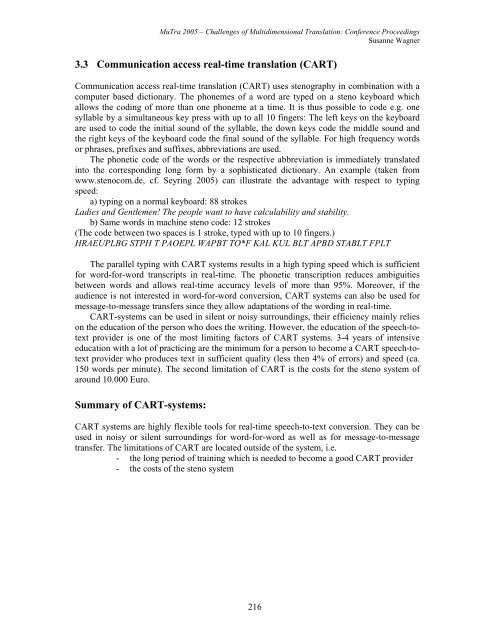Proceedings - Translation Concepts
Proceedings - Translation Concepts
Proceedings - Translation Concepts
Create successful ePaper yourself
Turn your PDF publications into a flip-book with our unique Google optimized e-Paper software.
MuTra 2005 – Challenges of Multidimensional <strong>Translation</strong>: Conference <strong>Proceedings</strong><br />
Susanne Wagner<br />
3.3 Communication access real-time translation (CART)<br />
Communication access real-time translation (CART) uses stenography in combination with a<br />
computer based dictionary. The phonemes of a word are typed on a steno keyboard which<br />
allows the coding of more than one phoneme at a time. It is thus possible to code e.g. one<br />
syllable by a simultaneous key press with up to all 10 fingers: The left keys on the keyboard<br />
are used to code the initial sound of the syllable, the down keys code the middle sound and<br />
the right keys of the keyboard code the final sound of the syllable. For high frequency words<br />
or phrases, prefixes and suffixes, abbreviations are used.<br />
The phonetic code of the words or the respective abbreviation is immediately translated<br />
into the corresponding long form by a sophisticated dictionary. An example (taken from<br />
www.stenocom.de, cf. Seyring 2005) can illustrate the advantage with respect to typing<br />
speed:<br />
a) typing on a normal keyboard: 88 strokes<br />
Ladies and Gentlemen! The people want to have calculability and stability.<br />
b) Same words in machine steno code: 12 strokes<br />
(The code between two spaces is 1 stroke, typed with up to 10 fingers.)<br />
HRAEUPLBG STPH T PAOEPL WAPBT TO*F KAL KUL BLT APBD STABLT FPLT<br />
The parallel typing with CART systems results in a high typing speed which is sufficient<br />
for word-for-word transcripts in real-time. The phonetic transcription reduces ambiguities<br />
between words and allows real-time accuracy levels of more than 95%. Moreover, if the<br />
audience is not interested in word-for-word conversion, CART systems can also be used for<br />
message-to-message transfers since they allow adaptations of the wording in real-time.<br />
CART-systems can be used in silent or noisy surroundings, their efficiency mainly relies<br />
on the education of the person who does the writing. However, the education of the speech-totext<br />
provider is one of the most limiting factors of CART systems. 3-4 years of intensive<br />
education with a lot of practicing are the minimum for a person to become a CART speech-totext<br />
provider who produces text in sufficient quality (less then 4% of errors) and speed (ca.<br />
150 words per minute). The second limitation of CART is the costs for the steno system of<br />
around 10.000 Euro.<br />
Summary of CART-systems:<br />
CART systems are highly flexible tools for real-time speech-to-text conversion. They can be<br />
used in noisy or silent surroundings for word-for-word as well as for message-to-message<br />
transfer. The limitations of CART are located outside of the system, i.e.<br />
- the long period of training which is needed to become a good CART provider<br />
- the costs of the steno system<br />
216
















